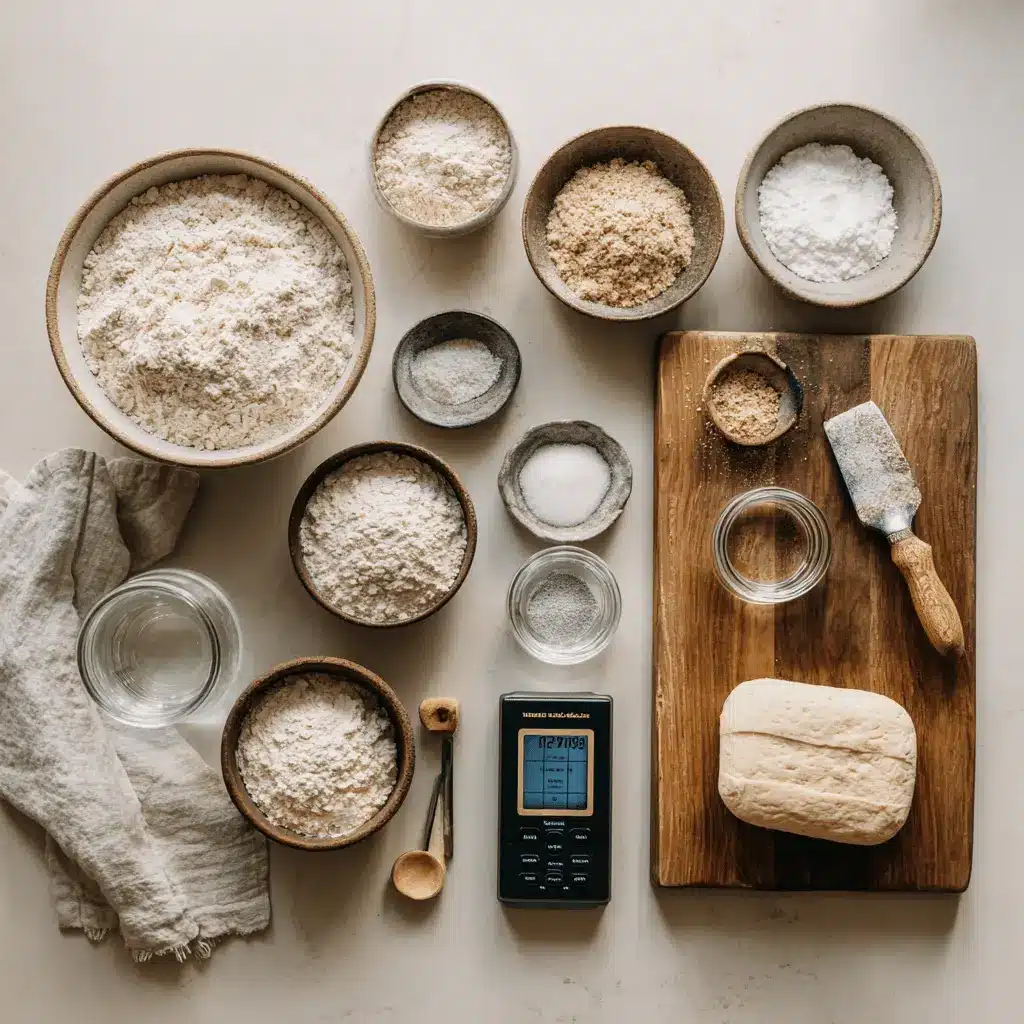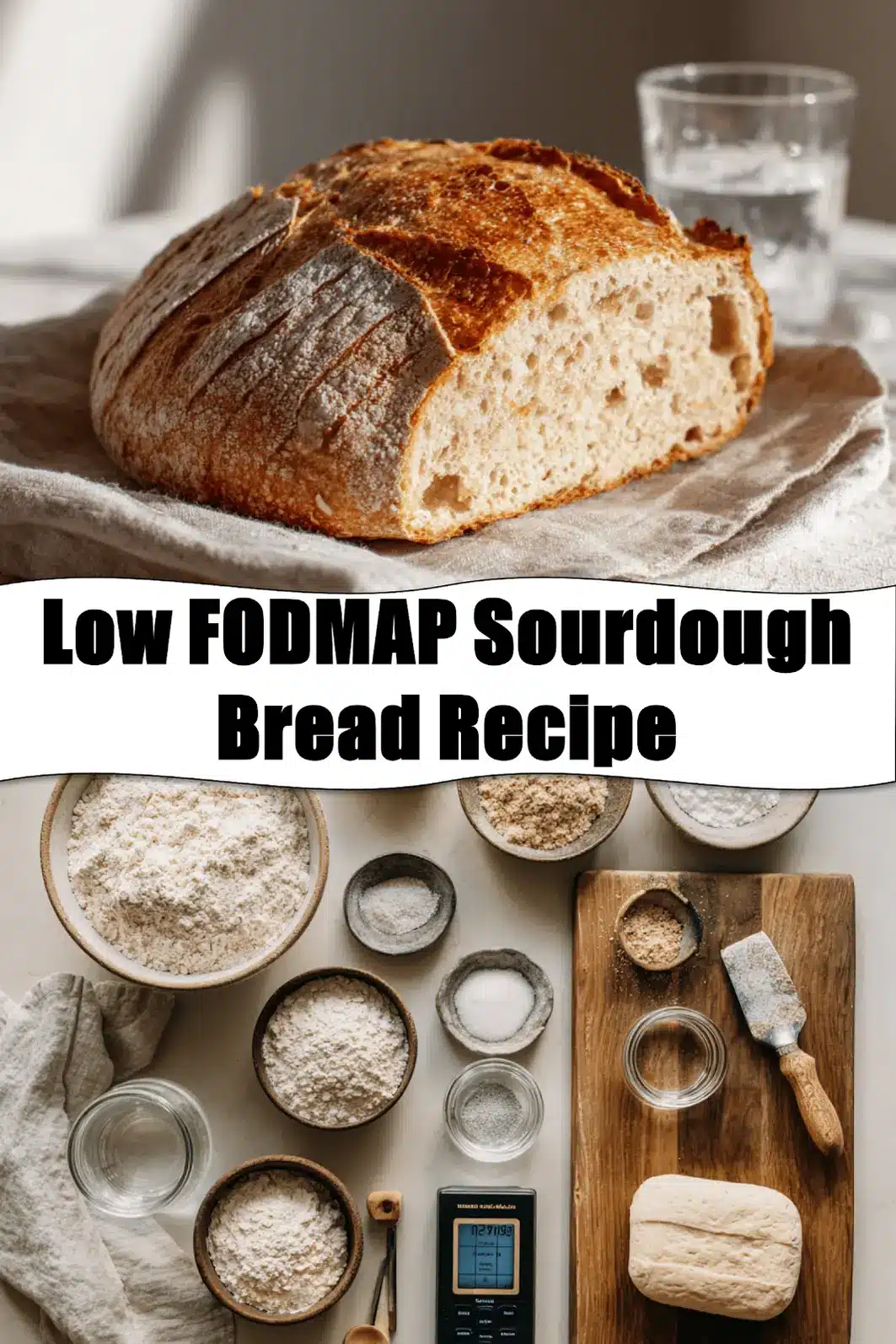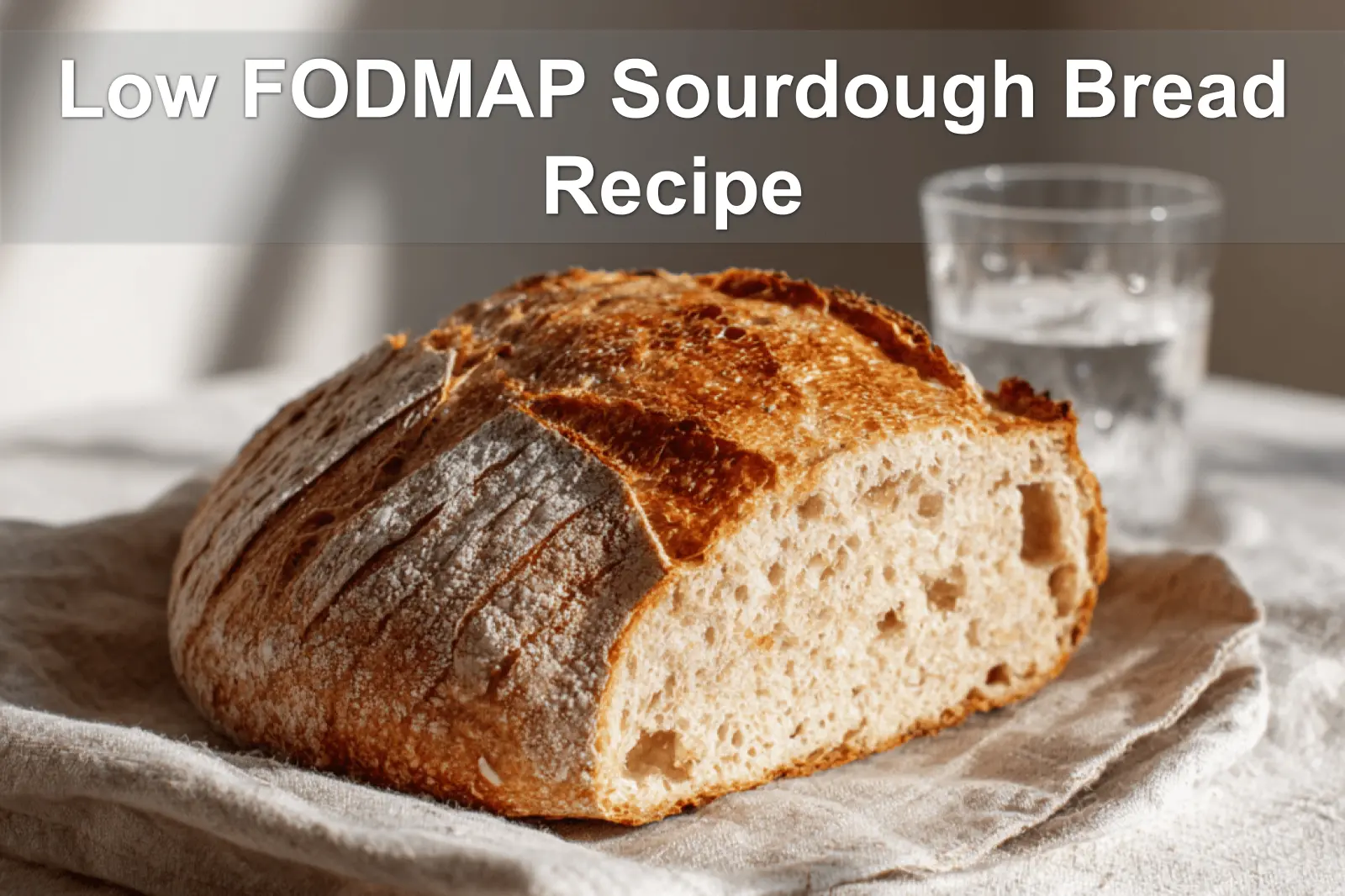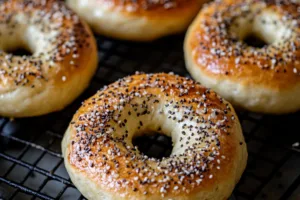Ever catch a whiff of warm crust and tangy rye, and boom—you’re back in grandma’s kitchen? That’s the magic of Low FODMAP Sourdough Bread. This recipe hit my Pinterest like a brick (a soft, golden, fluffy one). Folks with sensitive tummies are loving it on Reddit and TikTok. Beginner-friendly, just a bit of rise time, and you’ll have a wholesome, chewy loaf with a light, toasty crunch.
It’s a cozy homemade bread that soothes your gut and feeds your soul. Just flour, water, and a little patience. Pantry stuff, nothing fancy. Think your favorite bakery loaf—only easier, and a whole lot kinder to your belly. Full details in the blog!
My grandma started me on sourdough when I was barely tall enough to peek over the counter. I’ve baked it both ways—the hard way, the easy way—and this is the keeper. No mixers, no stress. Just one wild little trick I tested in our kitchen. You’ll love the secret!
Why This Recipe Works
Low FODMAP sourdough bread is the perfect blend of tradition and tummy-friendly innovation. By sticking to long fermentation, this bread breaks down those pesky fructans that can cause digestive discomfort. Grandma always said, “Time is the secret ingredient in good bread,” and she was spot on. The slow rise builds flavor while making it easier to digest—perfect for sensitive stomachs.
The combination of bread flour and whole grain spelt flour creates a magic texture: chewy, hearty, yet not too dense. Add in the sourdough’s natural tang, and it’s like a hug in bread form. Plus, using minimal ingredients keeps it approachable and stress-free for bakers of all levels. Let the starter do the hard work while you enjoy the quiet rhythm of baking.
Ingredients & Tools

The beauty of this recipe? It calls for just the basics:
- Bread Flour: The backbone of your loaf, giving structure and stretch.
- Whole Grain Spelt Flour: Nutty and nutrient-packed, it’s low FODMAP-friendly.
- Sourdough Starter: Your wild yeast buddy, bringing nothing but flavor and fluff.
- Water: Hydrates and binds everything together.
- Salt: Enhances flavor—don’t skip it!
You don’t need fancy equipment—just a mixing bowl, a wooden spoon, and a loaf pan. If you’re new to sourdough, a banneton (or even a clean kitchen towel in a bowl) can help during the proofing stage. Pro Tip: A kitchen scale is your best friend for consistent results!
Step-by-Step Process
Feeding the Starter: Start your prep the night before with a well-fed starter. Mix equal parts starter, spelt flour, and water, let it sit overnight, and by morning, you’ve got bubbly gold ready for action.
Mixing the Dough: Combine your flour, water, starter, and salt in a bowl. Stir until all the flour is incorporated. If the dough feels too dry, add a splash of water. Pro Tip: Don’t overthink this step; even a shaggy dough works wonders after resting.
Bulk Fermentation: Let the dough rise for 10 hours, performing stretch-and-folds every 30 minutes for the first 2 hours. This builds strength and structure without kneading—grandma called it “coaxing the dough.”
Troubleshooting Common Issues
If your bread feels too dense, it’s likely under-proofed. Let it rise longer during the bulk phase (cooler kitchens may need extra time). For those struggling with overproofing, don’t panic—your bread will still taste fantastic but may not have as much rise.
Pro Tip: If your crust isn’t quite right, make sure to create steam in the oven by adding that cup of water to a hot pan. This results in a beautifully golden, crackling crust.
| Issue | Fix |
|---|---|
| Dense Loaf | Let dough rise longer (double in size). |
| Pale Crust | Use steam when baking. |
| Flat Loaf | Handle dough gently during shaping. |
Customizations & Serving Ideas
This recipe is versatile. Mix flaxseeds, sunflower seeds, or sesame into the dough for added crunch and nutrition. Just fold them in during the final stretch-and-fold step. Prefer smaller loaves? Divide the dough into two mini loaf pans and reduce the baking time slightly.
Serving Ideas: Slice up this low FODMAP sourdough bread and pair it with salted butter, a drizzle of olive oil, or your favorite low FODMAP jam. It’s also heavenly with hearty soups or stews on a crisp fall evening. Bonus? It freezes beautifully—so bake now, enjoy later.
Expert Insight: The Science Behind Low FODMAP Sourdough Bread
Fermentation in sourdough not only enhances flavor but also breaks down fermentable carbohydrates, making this Low FODMAP Sourdough Bread Recipe suitable for sensitive digestive systems. The natural yeast and bacteria work together to reduce FODMAP content while improving shelf life and texture.
For more delicious recipes and cooking inspiration, follow me on Facebook, Pinterest and Reddit!
A Personal Slice of Comfort
Baking this Low FODMAP Sourdough Bread Recipe always reminds me of kneading dough alongside my grandmother, who taught me the magic of slow fermentation. It’s more than bread—it’s a comforting connection to family and a way to bring healthy, approachable meals to busy homes like yours.
FAQs ( Low FODMAP Sourdough Bread Recipe )
Is sourdough bread low FODMAP?
Yes, traditional sourdough can be lower in FODMAPs because the long fermentation allows lactic acid bacteria to break down some fermentable carbohydrates. Using a low FODMAP flour blend and extending the ferment time helps reduce FODMAP content further. Individual tolerance still varies, so start with a small serving to test how you react. If you have severe IBS, check with a registered dietitian for personalized advice.
What flours are safe for a Low FODMAP sourdough?
Safe choices often include rice flour, certified gluten-free oat flour, buckwheat flour, and certain low FODMAP commercial gluten-free blends available in the USA. Spelt or sourdough made from wheat may be tolerated by some people in small portions, but they can still be high FODMAP for others. Avoid high FODMAP flours like regular rye and large amounts of whole wheat unless you know you tolerate them. Always check package labels and start with tested servings.
How long should I ferment to reduce FODMAPs?
A longer fermentation generally helps reduce FODMAPs, so aim for a bulk ferment plus a proof that totals 12 to 24 hours, or use an overnight cold retard in the refrigerator. The exact time depends on your starter activity, room temperature, and flour choice, so watch the dough rather than the clock alone. Cold retarding for 12 to 18 hours is a practical method in many home kitchens. Remember that longer fermentation improves digestibility but also changes flavor and texture.
Can I use store-bought sourdough starter?
Yes, you can use a store-bought wild yeast sourdough starter, but check the label to avoid additives or unexpected ingredients. If the starter is dried or from a different flour base, feed and refresh it with your chosen low FODMAP flours for a few cycles so it adapts. Many bakers also prefer to build their own starter from scratch using the recipe flour for best results. Avoid starters that list sugars or preservatives on the ingredient list.
How should I store Low FODMAP sourdough bread to keep it fresh?
Store your sourdough at room temperature in a breathable bag or a cloth-lined basket for 1 to 2 days to keep the crust and crumb in good shape. For longer storage, slice and freeze the bread in airtight freezer bags and thaw slices as needed or toast them straight from frozen. Avoid refrigeration, which makes bread stale faster, unless you plan to use it in recipes. To refresh the crust, pop the loaf into a 350 F oven for 5 to 10 minutes.

Wrapping Up Your Low FODMAP Sourdough Bread Adventure
Whipping up this Low FODMAP Sourdough Bread Recipe gives you a tender, tangy loaf that feels like a warm kitchen hug—without any fuss. With just a bit of patience and simple pantry ingredients, you’ll have bread that’s as gentle on your tummy as it is on your soul. Trust me, you’ll wanna make it again and again.
Feel free to toss in seeds or swap spelt for oat flour to mix things up. Slice it fresh with butter or keep extras wrapped tight—this bread also freezes beautifully, perfect for busy days. A little kitchen magic, a lot of love, and you’re set.
Did this loaf bring back any family memories? Snap a pic and share what you added or changed—I’d love to hear your story. Pass this recipe on to a friend who’d cherish homemade baking as much as you do. Cozy moments are best shared, after all.

Low FODMAP Sourdough Bread Recipe for Easy Digestion
Ingredients
Method
- Feeding the Starter: Remove 25 grams of sourdough starter from the fridge. Mix with 25 grams whole grain spelt flour and 25 grams water in a glass jar. Stir well until no dry flour remains. Cover and mark the jar, let sit at room temperature for 4-12 hours until it doubles in size. The First Rise: Once starter has doubled, combine bread flour, whole grain spelt flour, water, salt, and 50 grams active starter in a mixing bowl. Stir until no dry flour remains; add a spoonful of water if dough feels dry. Cover and let rest 30 minutes. Stretch and Folds: Perform first set of stretch and folds by stretching each side (north, south, east, west) over the dough. Rest dough 30 minutes. Repeat stretch and fold two more times with 30-minute rests in between. After third fold, cover and let rise at room temperature until dough doubles in size (5-10 hours). Shaping: When doubled, sprinkle flour and flip dough onto counter. Flip sticky side down, pull edges to form a ball. Rest uncovered for 20-30 minutes. Final shape: Sprinkle flour on top, flip so floured side down, flatten dough into a rectangle. Roll into a log shape and place seam-side down in loaf pan. If pan isn’t non-stick, line with parchment paper. The Second Rise: Cover dough and refrigerate overnight or 8-12 hours to extend fermentation. Remove from fridge and let rise at room temperature until doubled and puffed over pan. Baking: Preheat oven to 450°F 30 minutes before baking and place a metal pan on bottom rack. Place loaf on middle rack and pour a cup of hot water into the bottom pan to create steam. Bake 20 minutes, remove steam pan, reduce oven to 400°F, and bake 15-20 more minutes until the internal temperature reaches 190°F. Cooling: Remove bread from pan and cool on wire rack for at least one hour before slicing.
Notes
- Use King Arthur Bread Flour and Bob’s Red Mill whole grain spelt flour for best results, though any whole grain spelt flour should work. Incorporating a long fridge proofing helps reduce FODMAPs by extending fermentation.












